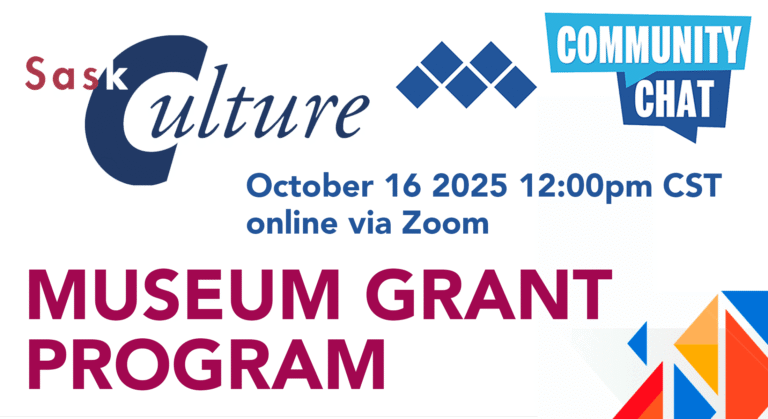
The MAS office will be closed for Christmas Holidays December 24th to January 4th.
Usual office hours will resume on January 5th, 2026
Have you ever gone to a Fowl Supper or a Pow Wow? Do you know what Vi-Co or a Chesterfield are? Do you remember learning to Quilt or watching a threshing crew? If you know what I’m referring to here then you’re aware of the intangible cultural heritage of this place – Saskatchewan. What’s got me thinking about what is intangible cultural heritage – hereafter referred to as ICH, you ask. Well I’ve actually been thinking about it for a while. Museums tend to focus on artefacts and buildings – tangible heritage. However, those things don’t tell the whole story. So much of our heritage is found in the stories, traditions, songs, and events we share – our intangible culture. We need to get better at documenting, preserving and sharing the intangible cultural heritage. We, at MAS have been talking about this for a while. From the Transformation Working Group’s Stuff to Stories recommendation in 2007 to the current Museums & Sustainability Initiatives where we’ve looked at a range of programs and activities which don’t always correlate directly to artefacts in the collection but are essential to a museum’s ability to preserve and share its community’s heritage.
A couple of weeks ago, I had the opportunity to attend the Intangible Cultural Heritage (ICH) Symposium co-sponsored by the Alberta Museums Association and the Canadian Commission for UNESCO. The Symposium, and the AMA conference which followed, were prompted by the fact that 2013 is the 10th anniversary of UNESCO’s adoption of the Convention for the Safeguarding of the Intangible Cultural Heritage. For more information check out – http://en.unesco.org/themes/intangible-cultural-heritage
The first presenter – Dr. Richard MacKinnon, Cape Breton University, Sidney, Nova Scotia, set the stage by defining ICH as basically ‘Living Heritage’. The Convention more fully defines ICH as:
“the practices, representations, expressions, knowledge, skills – as well as the instruments, objects, artefacts and cultural spaces associated therewith – that communities, groups and, in some cases, individuals recognize as part of their cultural heritage. This intangible cultural heritage, transmitted from generation to generation, is constantly recreated by communities and groups in response to their environment, their interaction with nature and their history, and provides them with a sense of identity and continuity, thus promoting respect for cultural diversity and human creativity.”
– UNESCO 2003
It goes on to say that ICH consists of: oral traditions and expressions, including language, as a vehicle of the intangible cultural heritage; performing arts; social practices, rituals and festive events; knowledge and practices concerning nature and the universe; and traditional craftsmanship amongst other things.
Since its presentation in 2003, 155 countries have ratified the Convention – Canada, unfortunately isn’t one of them. This is, in large part, why so little attention has been given to the whole area of intangible cultural heritage by either governments or academics in this country. However, in Newfoundland & Labrador, Quebec, and to an extent in Cape Breton, Nova Scotia things are happening both in the academic and in the heritage communities. Check out these websites for more details:
As for the rest of Canada, well I’d say that the fact that they co-sponsored this symposium and attached conference on the subject means that Alberta is looking seriously at ICH and museums. Here in Saskatchewan, I’ve seen interest increase in ICH over the last couple of years throughout the heritage sector.
Finally, for those of you who may not be from Saskatchewan the terms used at the beginning of this blog are: Fowl Supper – traditionally a church or community organized harvest supper at which you would always find turkey on the menu; Pow Wow – a First Nations Gathering celebrating life through dance, song, ceremony and fellowship; Vi-Co – Dairy Producers brand of chocolate milk and for those of a certain age the slang term for chocolate milk; and Chesterfield – what we call a sofa.
What do you consider to be examples of our intangible cultural heritage?

Usual office hours will resume on January 5th, 2026

Just a reminder that the Final Report for the Museum Improvement Micro Grant for Community Museums is due December 5th! Your final report will require you to provide a brief

Thursday October 16, 202512:00pm CSTOnline via Zoom: https://us02web.zoom.us/j/86760471705?pwd=XjoSlWAP0TJZVYrprylmLqujOkVrk2.1 No registration required. The Museum Grant Program (MGP) provides operational funding to help foster strong, vibrant, community-based Saskatchewan museums that are valued